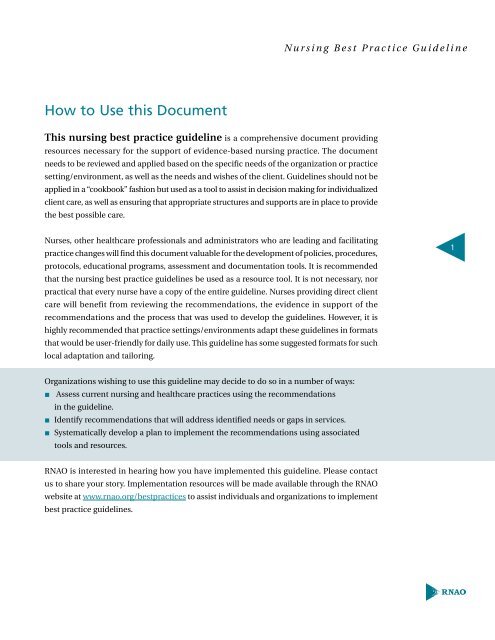Screening for Delirium, Dementia and Depression in Older Adults
Screening for Delirium, Dementia and Depression in Older Adults
Screening for Delirium, Dementia and Depression in Older Adults
- No tags were found...
You also want an ePaper? Increase the reach of your titles
YUMPU automatically turns print PDFs into web optimized ePapers that Google loves.
Nurs<strong>in</strong>g Best Practice Guidel<strong>in</strong>eHow to Use this DocumentThis nurs<strong>in</strong>g best practice guidel<strong>in</strong>e is a comprehensive document provid<strong>in</strong>gresources necessary <strong>for</strong> the support of evidence-based nurs<strong>in</strong>g practice. The documentneeds to be reviewed <strong>and</strong> applied based on the specific needs of the organization or practicesett<strong>in</strong>g/environment, as well as the needs <strong>and</strong> wishes of the client. Guidel<strong>in</strong>es should not beapplied <strong>in</strong> a “cookbook” fashion but used as a tool to assist <strong>in</strong> decision mak<strong>in</strong>g <strong>for</strong> <strong>in</strong>dividualizedclient care, as well as ensur<strong>in</strong>g that appropriate structures <strong>and</strong> supports are <strong>in</strong> place to providethe best possible care.Nurses, other healthcare professionals <strong>and</strong> adm<strong>in</strong>istrators who are lead<strong>in</strong>g <strong>and</strong> facilitat<strong>in</strong>gpractice changes will f<strong>in</strong>d this document valuable <strong>for</strong> the development of policies, procedures,protocols, educational programs, assessment <strong>and</strong> documentation tools. It is recommendedthat the nurs<strong>in</strong>g best practice guidel<strong>in</strong>es be used as a resource tool. It is not necessary, norpractical that every nurse have a copy of the entire guidel<strong>in</strong>e. Nurses provid<strong>in</strong>g direct clientcare will benefit from review<strong>in</strong>g the recommendations, the evidence <strong>in</strong> support of therecommendations <strong>and</strong> the process that was used to develop the guidel<strong>in</strong>es. However, it ishighly recommended that practice sett<strong>in</strong>gs/environments adapt these guidel<strong>in</strong>es <strong>in</strong> <strong>for</strong>matsthat would be user-friendly <strong>for</strong> daily use. This guidel<strong>in</strong>e has some suggested <strong>for</strong>mats <strong>for</strong> suchlocal adaptation <strong>and</strong> tailor<strong>in</strong>g.1Organizations wish<strong>in</strong>g to use this guidel<strong>in</strong>e may decide to do so <strong>in</strong> a number of ways: Assess current nurs<strong>in</strong>g <strong>and</strong> healthcare practices us<strong>in</strong>g the recommendations<strong>in</strong> the guidel<strong>in</strong>e. Identify recommendations that will address identified needs or gaps <strong>in</strong> services. Systematically develop a plan to implement the recommendations us<strong>in</strong>g associatedtools <strong>and</strong> resources.RNAO is <strong>in</strong>terested <strong>in</strong> hear<strong>in</strong>g how you have implemented this guidel<strong>in</strong>e. Please contactus to share your story. Implementation resources will be made available through the RNAOwebsite at www.rnao.org/bestpractices to assist <strong>in</strong>dividuals <strong>and</strong> organizations to implementbest practice guidel<strong>in</strong>es.
















